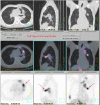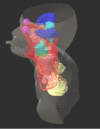Intensity modulated radiotherapy: advantages, limitations and future developments
- PMID: 21614217
- PMCID: PMC3097603
- DOI: 10.2349/biij.2.1.e19
Intensity modulated radiotherapy: advantages, limitations and future developments
Abstract
Intensity modulated radiotherapy (IMRT) is widely used in clinical applications in developed countries, for the treatment of malignant and non-malignant diseases. This technique uses multiple radiation beams of non-uniform intensities. The beams are modulated to the required intensity maps for delivering highly conformal doses of radiation to the treatment targets, while sparing the adjacent normal tissue structures. This treatment technique has superior dosimetric advantages over 2-dimensional (2D) and conventional 3-dimensional conformal radiotherapy (3DCRT) treatments. It can potentially benefit the patient in three ways. First, by improving conformity with target dose it can reduce the probability of in-field recurrence. Second, by reducing irradiation of normal tissue it can minimise the degree of morbidity associated with treatment. Third, by facilitating escalation of dose it can improve local control. Early clinical results are promising, particularly in the treatment of nasopharyngeal carcinoma (NPC). However, as the IMRT is a sophisticated treatment involving high conformity and high precision, it has specific requirements. Therefore, tight tolerance levels for random and systematic errors, compared with conventional 2D and 3D treatments, must be applied in all treatment and pre-treatment procedures. For this reason, a large-scale routine clinical implementation of the treatment modality demands major resources and, in some cases, is impractical. This paper will provide an overview of the potential advantages of the IMRT, methods of treatment delivery, and equipment currently available for facilitating the treatment modality. It will also discuss the limitations of the equipment and the ongoing development work to improve the efficiency of the equipment and the treatment techniques and procedures.
Keywords: IGRT; IMRT; dose optimisation; motion compensation.
Figures



















References
-
- Curran BH. Sternick ES. The Theory & Practice of Intensity Modulated Radiation Therapy. Advanced Medical Publishing; 1997. Conformal therapy using a multileaf intensity modulating collimator; pp. 75–90.
-
- Bortfeld TR, Kahler DL, Waldron TJ, et al. X-ray field compensation with multileaf collimators. Int J Radiat Oncol Biol Phys. 1994;28(3):723–30. - PubMed
-
- Spirou SV, Chui CS. Generation of arbitrary intensity profiles by dynamic jaws or multileaf collimators. Med Phys. 1994;21(7):1031–41. - PubMed
-
- Yu CX. Intensity-modulated arc therapy with dynamic multileaf collimation: an alternative to tomotherapy. Phys Med Biol. 1995;40(9):1435–49. - PubMed
-
- Adler JR, Cox RS. Preliminary clinical experience with the Cyberknife: Image-guided Stereotactic radiosurgery. Radiosurgery. 1995;1:316–26.
LinkOut - more resources
Full Text Sources
